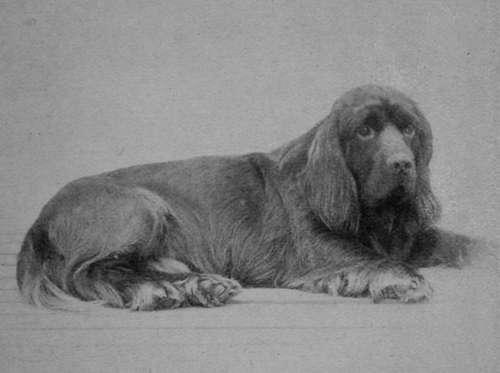The Sussex Spaniel
Description
This section is from the book "Sporting Dogs. Their Points And Management In Health, And Disease", by Frank Townend Barton. Also available from Amazon: Sporting Dogs; Their Points and Management in Health and Disease.
The Sussex Spaniel
This is a very old variety of Spaniel, said to have originated in the county of Sussex, in the locality of Rosehill.
Five-and-twenty years ago, typical specimens of the Rosehill strain were scarce, and since that time not a great deal has been done towards maintaining the purity of breed.

Mr Newington's Sussex Spaniel Dog Kosehill Rock.
Very few Spaniels shown in the Sussex classes can claim purity of breeding, the introduction of black blood by mating Champion Bachelor to Negress, being the cause of this. Jacobs Bachelor was by Buckingham ex Peggie and own brother to Rover III.—though very different types of Spaniels.
The author was personally acquainted with these and many other old Sussex Spaniels.
I always took Buckingham to be a very typical Sussex and Rover III. was much of the same stamp as his sire; whereas Bachelor was more akin to the Dam Peggie — of course much her superior, though quite unlike his brother, Rover III.
At one time the judges would not look at Champion Bachelor, Messrs Willet then preferring Rover III.
Later on the order was reversed, and we believe —though cannot be certain—at the London Kennel Club Show. Champion Lawyer—at one time in my possession—was a heavily built type of Sussex. The Rev. Mr Shields, Mr Fuller, and Mr Newington, all had some of the pure Rosehills, and I also bought a good bitch from Mr Henry Hawkins by Rover III. ex Duchess. The last time that old Buckingham ever appeared on the show bench—and then not for competition—was at the Royal Lancashire Agricultural Society's Show, held at Preston about 1880.
Although the litter out of which I bought Countess was an exceptionally good one—and Countess very typical—Messrs Willet would not award them prizes, owing, they said, to the faintest evidence of tan markings, observed with difficulty.
The typical colour for the Sussex is a light golden liver, and this Bachelor certainly was, Rover being darker.
Poor old Bachelor had a violent death through fighting with a kennel companion—a Gordon Setter.
Champion Rover III. was withdrawn from the show ring for some reason.
Even in those days animated discussion went on in the Press as to what was and what was not typical of the Sussex. There is no gainsaying one fact, and that is that the Sussex of twenty years ago existed in a different state of purity to what he does in the present day.
In casually looking over recent entries at the Kennel Club Show of Sussex Spaniels, it is questionable whether there is a single animal so entered that can justly claim the title of Sussex.
When Mr Jacobs had old Champion Bachelor in his possession, he had not more than one Sussex bitch to mate him with, to my recollection. There can be no doubt that the great improvement—for the show bench—of the modern Spaniels began when Jacobs crossed Bachelor with old Negress, a black Field Spaniel bitch. It destroyed the purity of the Sussex, but if it had not been indulged in, there would, in all probability, have been no class for the breed now. Blacks, livers, and liver and tan, all used to come in the same litter out of Negress, who certainly constituted the nucleus of a fortune to her owner.
The points of the Sussex are as follows:—
Colour
Deep golden liver.
Coat
Flat, and slightly wavy, but absolutely free from any tendency to curl. Soft and abundant.
Weight
About 40 lbs.
Head
Heavy, though smaller and lighter than that of the Clumber.
Eyes
Rather deeply set, giving the dog a very thoughtful expression.
Ears
These should be long and well clothed with long, silky hair. Above, the ears ought to be rather narrow, but broad below, set on low down, and carried close to sides of head.
Nose
Broad and liver-coloured, open nostrils.
Neck
Short and strong, and the back long, strong, and level.
Shoulders And Chest
A fairly deep chest, oblique shoulders, and well-sprung ribs are necessary.
Flat-sidedness, and " tucked up under" are decidedly faulty.
Fore Limbs
Must be short on the leg. Arms and fore-arms short but well boned. Crooked fore-limbs are objectionable; turned out at elbows equally bad. There should be an abundance of feather springing from the backs of the fore-limbs, and down to the hocks, in the hind ones.
For the show bench the more feather the better.
Feet also well feathered, round and strong. The chief faults of the Sussex are: white hairs on any portion, tan markings, curly coat, too leggy, light in body, snipy head, short ears, want of feather, bad constitution, and Bloodhound expression on face.
Continue to:
- prev: The Clumber
- Table of Contents
- next: Field Spaniels
